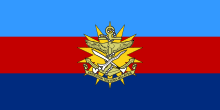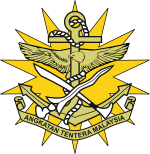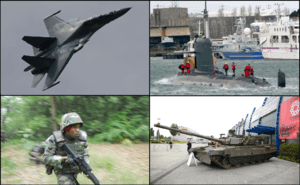Malaysian Armed Forces
The Malaysian Armed Forces (MAF, Malay: Angkatan Tentera Malaysia-ATM; Jawi:اڠكتن تنترا مليسيا), are the military of Malaysia, consists of three branches, namely the Malaysian Army, Royal Malaysian Navy and the Royal Malaysian Air Force. Since June 20. 2018, General Tan Sri Affendi Buang RMAF is the Chief of Malaysian Armed Forces.
| Malaysian Armed Forces | |
|---|---|
| اڠكتن تنترا مليسيا Angkatan Tentera Malaysia | |
 Flag of the Malaysian Armed Forces | |
 Crest of the Malaysian Armed Forces | |
| Founded | 1 March 1933 |
| Service branches | |
| Website | www.mafhq.mil.my |
| Leadership | |
| Commander-in-Chief | Yang Di-Pertuan Agong Abdullah of Pahang |
| Minister of Defence | Ismail Sabri Yaakob |
| Chief of Defence Forces | General Tan Sri Affendi Buang RMAF |
| Manpower | |
| Military age | 18 years of age |
| Available for military service | 15,000,000, age 18–49 (2017 est) |
| Fit for military service | 12,425,000, age 18–49 (2017 est) |
| Reaching military age annually | 520,000 (2017 est) |
| Active personnel | 110,000 (2019)[1][2] |
| Reserve personnel | 310,000 (2019)[3] |
| Expenditures | |
| Budget | MYR15.1 bn (US$3.6 b)FY2017[4] |
| Percent of GDP | 1.16% (FY2016 Q4 $311b) |
| Industry | |
| Domestic suppliers |
|
| Foreign suppliers | |
| Related articles | |
| History | Military history of Malaysia |
| Ranks | Malaysian Armed Forces ranks and insignia |
| Components | |||||||||
|---|---|---|---|---|---|---|---|---|---|
| Malaysian Army | |||||||||
| Royal Malaysian Navy | |||||||||
| Royal Malaysian Air Force | |||||||||
| History | |||||||||
| Military history of Malaysia | |||||||||
| Related information | |||||||||
| Awards & decorations | |||||||||
| Special Operations Force | |||||||||
| Council | |||||||||
| National service | |||||||||
| Military manpower | |||||||||
| |||||||||
| Military expenditure | |||||||||
| |||||||||
Source : IHS Jane's | |||||||||
Background
Malaysia's armed forces were created from the unification of military forces which arose during the first half of the 20th century when Malaya and Singapore were the subjects of British colonial rule before Malaya achieved independence in 1957. The primary objective of the armed forces in Malaysia is to defend the country's sovereignty and protect it from any and all types of threats.[6]
It is responsible for assisting civilian authorities to overcome all international threats, preserve public order, assist in natural disasters and participate in national development programs. It is also sustaining and upgrading its capabilities in the international sphere to uphold the national foreign policy of being involved under the guidance of the United Nations (UN).
Theater of Operation
The main theaters of operations were within Malaysian borders, primarily to fight an insurgency led by the Communist Party of Malaya (CPM) in what was known as the Emergency. The only foreign incursion of Malaysian territory in modern times were in World War II by Japan (Malaya was then not a unified political entity and consisted of the British Crown Colony of the Straits Settlements, and the British protected Federated Malay States and Unfederated Malay States) and during the Indonesia-Malaysia confrontation by Indonesia under the leadership of President Sukarno. Operations on foreign soil have mainly been peacekeeping operations under the auspices of the United Nations.
- First Emergency (1948–1960)
- An insurrection and guerrilla war of the Malayan Races Liberation Army organised by the CPM against the British and Malayan administration.
- Moro attacks on Malaysia (Part of the Piracy in the Sulu Sea) (1962–present)
- Congo Peacekeeping Mission (1960–1962)
- A contingent of 1,947 personnel were dispatched as part of the United Nations Operation in the Congo or ONUC. This contingent was known as the Malayan Special Force to the Congo and their experiences there were later recounted through the drawings of the cartoonist, Rejabhad.
- Sarawak Communist Insurgency (1963–1990)
- An insurrection and guerrilla war of the Sarawak Communist Organisation (from 1971, the North Kalimantan Communist Party or NKCP) against the British and Malaysian governments to establish an independent nation comprising the states of Sabah, Sarawak and Brunei. The insurgency ended when the NKCP signed a peace treaty with the Malaysian government in 1990.
- Indonesia-Malaysia confrontation (1963–1966)
- An intermittent armed conflict between Malaysia and Indonesia with skirmishes mainly occurring in Sarawak and Sabah in the island of Borneo. In 1964, armed raids were made on Peninsular Malaysia. Combat eased with the deposing of Indonesia's President Sukarno in 1965 by the Indonesian army and the conflict was declared over by both sides in 1966.
- Communist insurgency in Malaysia (1968–89)
- A low level resurgence of insurgent activity by the armed elements of the CPM from sanctuaries in the Malaysian-Thai border. The insurgency was only ended after the CPM signed a peace treaty with the Governments of Malaysia and Thailand on 2 December 1989.
- Iran/Iraq Border (1988–1991)
- Participated as part of the UN Iran-Iraq Military Observer Group (UNIIMOG) to supervise the Iran–Iraq War ceasefire.
- Namibia (1989–1990)
- Contributed a battalion to the UN Transition Assistance Group (UNTAG) to supervise Namibia's elections and transition to independence.
- Western Sahara (1991–present)
- A contingent of observers under the Mission for the Referendum in Western Sahara (MINURSO) to help implement a ceasefire between the Polisario Front & Morocco and help promote referendum on area's future.
- Angola (1991–1995)
- A contingent was sent under the United Nations Angola Verification Mission II (UNAVEM II) to enforce the ceasefire in Angolan civil war.
- Iraq/Kuwait Border (1992–2003)
- A contingent was sent under the United Nations Iraq-Kuwait Observation Mission (UNIKOM) to monitor the demilitarised zone along the Iraq-Kuwait border, deter border violations and report on any hostile action.
- Cambodia (1992–1993)
- An observer team was sent under the United Nations Transitional Authority in Cambodia (UNTAC) to aid in the administration of Cambodia and to organise and run elections.
- Bosnia and Herzegovina (1993–1998)
- A peacekeeping contingent known as MALBATT Command (Malaysia Battalion) was sent initially under the United Nations Protection Force (UNPROFOR) from 1993–1995 with deployments at Konjic, Jablanica and Pazarić in Hadžići. Following the Dayton Agreement, forces were redeployed as MALCON Command (Malaysia Contingent) under the NATO led Implementation Force (IFOR) in Operation Joint Endeavor with deployments at Livno, Glamoč and Kupres. MALCON further participated as part of the NATO led Stabilisation Force (SFOR) until 1998. Up to 8,000 troops were eventually deployed in this theatre of operations.
- Liberia (1993–1997)
- An observer team of 3 officers was sent under the United Nations Observer Mission in Liberia (UNOMIL) to support the efforts of the Economic Community of West African States (ECOWAS) and the Liberian National Transitional Government to implement peace agreements signed between the warring parties in Liberia.
- Somalia (1993–1994)
- A contingent known as MALBATT was sent under the United Nations Operation in Somalia II (UNOSOM II) to take appropriate action, including enforcement measures, to establish throughout Somalia a secure environment for humanitarian assistance. During its deployment, MALBATT was involved in the Battle of Mogadishu which saw 1 personnel killed in action and 7 others wounded in action during the relief operations to aid the surrounded troops of the United States' Task Force Ranger. On 18 January 1994, Lieutenant General Abu Samah Bin Abu Bakar was appointed the Commander of UNOSOM II forces. His appointment also saw the United Nations revise the mandate of UNOSOM II to stop using "coercive methods" in the discharge of their duties while retaining "some capability to defend its personnel if circumstances so warrant."[7]
- Mozambique (1993–1995)
- A team of observers were sent under the United Nations Operations in Mozambique (ONUMOZ).
- Lahad Datu standoff (2013)
- Deployed in South Lebanon on peace keeping role at present after the withdrawal of Israeli Military forces early 2007 (Invasion of South Lebanon by Israeli Military). Unit also consist of GGK, PASKAL, PASKAU and PARA elements.[8]
(The rest of the entries below require a clean-up)
- Deployed a contingent called Malaysian Medical Team (MASMEDTIM) to Chaman, Pakistan to treat refugees from Afghanistan during the US invasion of Afghanistan in 2001.
- Deployed approximately a brigade-sized force on islands surrounding Sabah waters in Ops Pasir to prevent the recurrence of 2000 Sipadan kidnappings.
- Deployed a contingent to Acheh after the tsunami disaster in 2004.
- Deployed MASMEDTIM to Pakistan during the 2005 quake.
- Deployed in Southern Philippines as a part of monitoring force agreed upon by both the Philippine Government and Moro Islamic Liberation Front (MILF).
- Deployed in East Timor/East Leste together with Australian, Portuguese and New Zealand forces at the request of East Timor Government. The first team of 25 soldiers from 10 Para Brigade, Royal Intelligence Corp and Commando Regiment were deployed on a fact-finding mission before being reinforced by another 209 soldiers. (as at 27 May 2006)
Other limited participation under UNPKO are United Nations International Police Force (UNIPTF) since December 1995; United Nations Mission in Kosovo (UNMIK) since June 1999; United Nations Observer Mission in Sierra Leone (UNAMSIL) since October 1999; United Nations Transitional Administration in East Timor (UNTAET) since September 1999 and United Nations Organisation Mission in Democratic Republic of Congo (MONUC) since February 2000. 18 Malaysian Armed Forces personnel have been killed during UN peacekeeping operations.
Present Development

Malaysian defence requirements are assigned to the Malaysian Armed Forces (Angkatan Tentera Malaysia – ATM). The armed forces has three branches,the Malaysian Army (Tentera Darat Malaysia – TDM), Royal Malaysian Navy (Tentera Laut Diraja Malaysia – TLDM) and the Royal Malaysian Air Force (Tentera Udara Diraja Malaysia – TUDM). Malaysia does not have conscription, and the required minimum age for voluntary military service is 18.[9]
In the early 1990s, Malaysia undertook a major program to expand and modernise its armed forces. However, budgetary constraints imposed by the 1997 Asian financial crisis held many of the procurement. The recent economic recovery may lead to relaxation of budgetary constraints on the resumption of major weapons purchases. In October 2000, the Defence Minister also announced a review of national defence and security policy to bring it up to date. The review addressed new security threats that have emerged in the form of low intensity conflicts, such as the kidnapping of Malaysians and foreigners from resort islands located off the east coast of the state of Sabah and risk rising territory dispute with several neighbour countries. Currently, 1.4% of Malaysia's GDP is spent on the military, which employs 1.23% of Malaysia's manpower.[9] Dr Kogila Balakrishnan is the head of the Defence Industry.
Malaysian Army

Since the recovery from the 1997 economic crisis, the army's modernisation programme has gained momentum. The acquisition of Main Battle Tank (MBT), Armoured Personnel Carrier (APC), Infantry Fighting Vehicle (IFV) and modern artillery make the army as one of the potent power in the region.
Royal Malaysian Navy
_and_KD_Jebat(FFG29)_with_USS_George_Washington_(CVN_73).jpeg)
Following the completion of the New Generation Patrol Vessel (NGPV) program, Malaysia now moved to the next program called Second Generation Patrol Vessel (SGPV). Malaysia is also looking to purchase more submarine as well as a batch of Multi-Role Support Ship (MRSS). In addition, an upgrade programme and Service Life Extension Programme (SLEP) for the old navy's ship will keep the fleet modern with the latest technology needed.
Royal Malaysian Air Force
.jpg)
RMAF has traditionally looked to the West for its purchases, primarily to the United States and Europe. However, limitation imposed by the United States on "new technology" to the region made RMAF consider purchases from Russia and other non-traditional sources. Currently, RMAF operates a unique mix of American, European and Russian-made aircraft.
National Service
In early 2004, the Ministry of Defence also initiated a compulsory National Service program for 18 years old Malaysians. Participants of the Malaysian National Service are chosen randomly. Currently, only 20% of those eligible are inducted but plans call for this program to eventually cover all 18-year-old adults.
Although under the purview of the Ministry of Defence, the National Service is not a military programme. Draftees are taught basic hand-to-hand combat and handling of certain weapons, including Colt M16s by military instructors, but are not expected to be conscripted or called into military draft. It is described as a nation and community building programme and incorporate other training modules including character learning and civics.
As of 2018, the Malaysian government has abolished the national service due to the lack of fund and the previous mismanagement of programme leading to myriad of complaints. Currently, individual over 18 are still able to participate in the program, but need to register for themselves and are not forcibly selected like before.[10]
Forming of Marines Corps
Defence Minister Hishammuddin Tun Hussein said in a statement on 10 October 2013, Malaysia is planning on establishing a marines corps for amphibious operation.[11] The marine will be drawn from all three services and the bulk of it is from one of the three parachute battalions of the 10 Paratrooper Brigade which will be re-designated as a marine battalion. The 9th Royal Malay Regiment (para) and 8th Royal Ranger Regiment (para) have both conducted amphibious warfare training as a secondary mission such as CARAT exercise with the US Marine Corps (USMC) and others amphibious exercise also conducted with other foreign armed forces.
Defence Industry
For a long time after independence, Malaysia moving forward by establishing and develop their own defence industry. Local company such as DefTech, Weststar Defence Industries, Boustead Heavy Industries, AIROD, ATSB, ATSC, Composites Technology Research Malaysia, SME Aerospace and SME Ordnance are the domestic suppliers of defence products and services to the Malaysian Armed Forces.
There is also a new development unveiled during the celebration of the Malaysia's 50th independence. It is a laser guide projectile code name Taming Sari XK98 developed by STRIDE, but no further details were enclosed. It was first spotted by the public when it participated the celebration parade. Another local company Aegis Malinnov also developed new pistols intended to be uses by Malaysian government and agencies.[12]
In addition, Malaysia also improved their defence industry through their defence companies by locally manufactured and produced weapons such as ammunitions, rifles, armoured cars, warships and light aircraft including UAVs for the armed forces.[13]
International Action
The Five Power Defence Arrangement (FPDA) between Malaysia, Singapore, Australia, New Zealand, and the United Kingdom, is a regional security initiative which has been in place for more than 45 years. It involves joint military exercises held between the five countries.[14]
Malaysia also actively takes part in international exercise such as CARAT[15], RIMPAC[16] and COPE[17]. Joint exercises and war games also been held with Brunei,[18] China,[19] Indonesia[20] and the United States.[21] Besides that, Malaysia, Philippines, Thailand and Vietnam have agreed to host joint security force exercises to secure their maritime border and tackle issues such as illegal immigration, piracy and smuggling.[22][23][24]
Previously there are fears that extremist militants activities in the Muslim areas of the southern Philippines[25] and southern Thailand[26] could spill over into Malaysia. Due to this, Malaysia began to increase its border security.[25]
Equipment
See also
References
- "2017 Malaysia Military Strength". globalfirepower.com. Retrieved 22 March 2018.
- "Malaysian Armed Forces". GlobalSecurity.org.
- https://www.globalfirepower.com/country-military-strength-detail.asp?country_id=malaysi%5B%5D
- "Malaysia announces 5.3% defence budget increase - Jane's 360". www.janes.com. Archived from the original on 7 March 2018. Retrieved 22 March 2018.
- "Arms Transfers". Stockholm International Peace Research Institute. Retrieved 30 August 2015.
- Babatunde Fagoyinbo, Joseph (2013). The Armed Forces: Instrument of Peace, Strength, Development and Prosperity. Author House. ISBN 1477218440.
- UN Chronicle: "Mandate for UNOSOM II revised; 'coercive methods' not to be used – UN Operation in Somalia emphasizes nation building", June 1994
- "UNIFIL Troop-Contributing Countries". UNIFIL. 14 March 2016. Retrieved 2 October 2019.
- "Malaysian Military statistics". NationMaster. Retrieved 1 October 2010.
- https://www.malaymail.com/news/malaysia/2017/03/19/teens-no-longer-forced-to-attend-national-service/1338239
- "Malaysia to establish marine corps, naval base close to James Shoal". IHS Jane's 360. Retrieved 18 October 2013.
- https://aegismalinnov.com/
- https://www.jstor.org/stable/26459817?seq=1#metadata_info_tab_contents
- "Australia says major military exercise underway in Malaysia". My Sinchew. 26 April 2010. Archived from the original on 3 March 2016. Retrieved 1 October 2010.
- https://www.pacom.mil/Media/News/News-Article-View/Article/613812/us-sailors-and-marines-join-the-malaysian-armed-forces-for-carat-2015/#:~:text=U.S.%20Sailors%20and%20Marines%20Join%20the%20Malaysian%20Armed%20Forces%20for%20CARAT%202015,-By%20Task%20Force&text=Sandakan%2C%20Malaysia%20%2D%2D%20The%2021st,opening%20ceremonies%20in%20Sandakan%2C%20Malaysia.
- https://thediplomat.com/2018/04/a-first-malaysia-to-deploy-warship-for-rimpac-2018/#:~:text=Malaysia%20will%20send%20a%20warship,exercise%20for%20the%20first%20time.&text=Malaysia's%20involvement%20in%20RIMPAC%2C%20which,southern%20California%2C%20is%20not%20new.
- https://www.pacom.mil/Media/Photos/igphoto/2001572749/
- Wood, Daniel (20 April 2014). "Brunei, M'sia train in 11th military exercise". The Brunei Times. Archived from the original on 8 December 2014. Retrieved 5 November 2014.
- "Joint table top exercise between armies of China, Malaysia kicks off in Malaysia". Global Times. Xinhua News Agency. 22 December 2014. Retrieved 24 December 2014.
- "Indonesia-Malaysia military exercises must continue – defence minister". ANTARA News. 13 September 2010. Retrieved 1 October 2010.
- "Malaysia, US armed forces in joint exercise". The Star. 25 August 2014. Retrieved 26 August 2014.
- "Malaysia, Philippines committed to enhancing border security". My Sinchew. 9 August 2010. Archived from the original on 3 March 2016. Retrieved 18 September 2010.
- "Piracy in Southeast Asia: Organised Criminal Syndicates or Small Scale Opportunists?" (PDF). Gray Page. April 2013. Archived from the original (PDF) on 24 July 2015. Retrieved 24 July 2015.
- Carvalho, Martin (15 May 2012). "Malaysia, Thailand military exercise to include other agencies, Asean members". The Star. Retrieved 5 November 2014.
- Pike, John. "Malaysia Intensifies Border Security Following US Warnings". GlobalSecurity.org. Retrieved 18 September 2010.
- Kent, Jonathan (28 April 2004). "Malaysia ups Thai border security". BBC News. Retrieved 18 September 2010.
Further reading
- Robert Karniol, 'Country Briefing: Malaysia,' Jane's Defence Weekly, 25 November 1995, p. 25–40
External links
| Wikimedia Commons has media related to Military of Malaysia. |

.svg.png)